Ah, summer—those gloriously long days with plenty of time to take part in fun activities, such as diving into a good book! Check out these recently published titles that take readers on road trips, to summer camp, into nature, and on vacation.
Ages 4–8
Calling All Cars. Sue Fliess. Ill. Sarah Beise. 2016. Sourcebooks Jabberwocky.
 Cars, cars, cars! All kinds of cars driven by a full cast of animal characters make this simple rhyming text a fun choice for young readers who love to talk about cars. Where are the cars headed? Everywhere—to the beach, to town, to the mountains, and to campsites, just to name a few places. This rhythmic book is a great choice to take on a summer road trip to stave off pleas of “Are we there yet?” Brightly colored cartoon-style illustrations created digitally complement the text in this engaging concept book.
Cars, cars, cars! All kinds of cars driven by a full cast of animal characters make this simple rhyming text a fun choice for young readers who love to talk about cars. Where are the cars headed? Everywhere—to the beach, to town, to the mountains, and to campsites, just to name a few places. This rhythmic book is a great choice to take on a summer road trip to stave off pleas of “Are we there yet?” Brightly colored cartoon-style illustrations created digitally complement the text in this engaging concept book.
Finding Wild. Megan Wagner Lloyd. Ill. Abigail Halpin. 2016. Alfred A. Knopf/Random House.
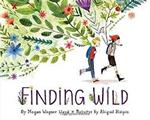 Nothing goes together better than summertime and exploring. In this poetic and thought-provoking picture book, a young boy and girl set off to explore the wild spaces around them. A feast for the senses, this story describes what wild looks, feels, smells, sounds, and tastes like, and it reminds readers that wild can hide in the most unusual of places, and finding wild is possible for everyone no matter where they live. Detailed watercolor-and-colored pencil illustrations add a muted beauty to the text.
Nothing goes together better than summertime and exploring. In this poetic and thought-provoking picture book, a young boy and girl set off to explore the wild spaces around them. A feast for the senses, this story describes what wild looks, feels, smells, sounds, and tastes like, and it reminds readers that wild can hide in the most unusual of places, and finding wild is possible for everyone no matter where they live. Detailed watercolor-and-colored pencil illustrations add a muted beauty to the text.
Lady Liberty’s Holiday. Jen Arena. Ill. Matt Hunt. 2016. Alfred A. Knopf/Random House.
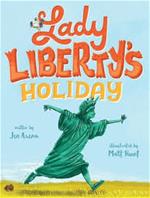 The Statue of Liberty is tired of standing in her same spot on Ellis Island day after boring day, and besides that her neck hurts from always holding her arm up over her head. Moe the Pigeon urges Lady Liberty to take a vacation, so one night she puts down her torch and tablet and sneaks away to see the rest of America. Readers follow Lady Liberty on a map as she travels from the Jersey Shore to the Great Midwest and all the way out to California to see the Golden Gate Bridge. But back in New York, people miss her and desperately hope she’ll return in time for the Fourth of July celebration. The brightly colored illustrations are a combination of digital and traditional pencil-and-paint artwork. Back matter includes background information on the Statue of Liberty, a page of trivia related to the statue, and a bibliography.
The Statue of Liberty is tired of standing in her same spot on Ellis Island day after boring day, and besides that her neck hurts from always holding her arm up over her head. Moe the Pigeon urges Lady Liberty to take a vacation, so one night she puts down her torch and tablet and sneaks away to see the rest of America. Readers follow Lady Liberty on a map as she travels from the Jersey Shore to the Great Midwest and all the way out to California to see the Golden Gate Bridge. But back in New York, people miss her and desperately hope she’ll return in time for the Fourth of July celebration. The brightly colored illustrations are a combination of digital and traditional pencil-and-paint artwork. Back matter includes background information on the Statue of Liberty, a page of trivia related to the statue, and a bibliography.
Penny & Jelly Slumber Under the Stars. Maria Gianferrari. Ill. Thyra Heder. 2016. Houghton Mifflin Harcourt.
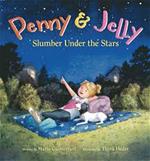 Penny is excited to go to Sleepover Under the Stars Night at the local community center, but she doesn’t want to leave her dog, Jelly, behind. Penny tries to construct a pretend Jelly out of paper, yarn, fleece, pipe cleaners, cotton balls, marshmallows, and more but can’t quite duplicate the real Jelly, no matter how hard she tries. So Penny comes up with the perfect solution: Have her own under the stars sleepover—furry friends invited! Colorful, expressive illustrations in watercolor, pencil, and ink perfectly detail Penny’s plans.
Penny is excited to go to Sleepover Under the Stars Night at the local community center, but she doesn’t want to leave her dog, Jelly, behind. Penny tries to construct a pretend Jelly out of paper, yarn, fleece, pipe cleaners, cotton balls, marshmallows, and more but can’t quite duplicate the real Jelly, no matter how hard she tries. So Penny comes up with the perfect solution: Have her own under the stars sleepover—furry friends invited! Colorful, expressive illustrations in watercolor, pencil, and ink perfectly detail Penny’s plans.
Surf’s Up. Kwame Alexander. Ill. Daniel Miyares. 2016. NorthSouth.
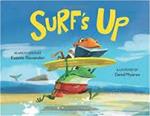 Two cool frogs who call each other Bro and Dude love to surf. On their way to the beach, Bro has his nose in a book, which Dude thinks, at first, is boring. However, he soon gets caught up in Bro’s plot tidbits. Brightly colored cartoon-style, digitally created illustrations and plenty of all-caps typography add to the feeling of excitement of a day of both surfing and reading in this story. Adults will enjoy the Moby-Dick references as Bro gives Dude a scene-by-scene account of what is happening in the “TOTALLY AWESOME” book he is reading.
Two cool frogs who call each other Bro and Dude love to surf. On their way to the beach, Bro has his nose in a book, which Dude thinks, at first, is boring. However, he soon gets caught up in Bro’s plot tidbits. Brightly colored cartoon-style, digitally created illustrations and plenty of all-caps typography add to the feeling of excitement of a day of both surfing and reading in this story. Adults will enjoy the Moby-Dick references as Bro gives Dude a scene-by-scene account of what is happening in the “TOTALLY AWESOME” book he is reading.
Ages 9–11
The Family Fletcher Takes Rock Island. Dana Alison Levy. 2016. Delacorte/Random House.
 The Fletcher family is back for a second adventure as they head to Rock Island for their annual monthlong beach vacation. Dad and Papa and their four adopted sons, Sam, Jax, Eli, and Frog, love to return to their beloved island home every summer and do all of their favorite things, like kayaking out to see the seals and exploring inside the old lighthouse. But this summer, the lighthouse is closed for reasons they can’t quite figure out, and new neighbors have taken over some of their favorite beach spots. This summer-themed book will inspire conversations about adapting to change, creating new traditions, and celebrating the power of family—no matter what your family looks like.
The Fletcher family is back for a second adventure as they head to Rock Island for their annual monthlong beach vacation. Dad and Papa and their four adopted sons, Sam, Jax, Eli, and Frog, love to return to their beloved island home every summer and do all of their favorite things, like kayaking out to see the seals and exploring inside the old lighthouse. But this summer, the lighthouse is closed for reasons they can’t quite figure out, and new neighbors have taken over some of their favorite beach spots. This summer-themed book will inspire conversations about adapting to change, creating new traditions, and celebrating the power of family—no matter what your family looks like.
Ocean Animals: Who’s Who in the Deep Blue. Johnna Rizzo. 2016. National Geographic Kids.
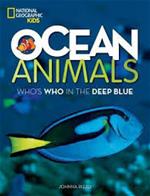 Heading to the beach this summer? Take along this fantastic nonfiction manual that explores life in and near the ocean in spectacular detail. Featuring topics such as Oceans of the World, Coral Reefs, Sharks & Rays, Marine Birds, and Ocean Habitats, this book will keep readers (including the landlocked who wish they were at the beach) occupied for hours as they pore over the full-color photographs and descriptive text. Text features include a table of contents, detailed diagrams, photo captions, a glossary, and index. In National Geographic style, this book also includes a section on conservation and what kids (and adults) can do to protect the oceans of the world.
Heading to the beach this summer? Take along this fantastic nonfiction manual that explores life in and near the ocean in spectacular detail. Featuring topics such as Oceans of the World, Coral Reefs, Sharks & Rays, Marine Birds, and Ocean Habitats, this book will keep readers (including the landlocked who wish they were at the beach) occupied for hours as they pore over the full-color photographs and descriptive text. Text features include a table of contents, detailed diagrams, photo captions, a glossary, and index. In National Geographic style, this book also includes a section on conservation and what kids (and adults) can do to protect the oceans of the world.
Summer of Lost and Found. Rebecca Behrens. 2016. Aladdin/Simon & Schuster.
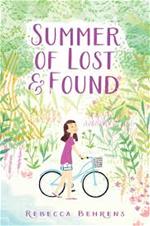 Nell Dare’s perfect summer plans are ruined when her botanist mother announces that she and Nell are going to spend the summer in North Carolina on Roanoke Island for a research trip. And to make matters worse, Nell’s father disappeared to London on an unannounced trip, and no one will tell her why he left or if he is coming back. Upon arriving at their destination, Nell makes a few friends who fill her in on the historical mystery of the Lost Colony of Roanoke. The modern-day story is set beside journal entries told in the voice of one of the colonists. Back matter includes an author’s note, which helps readers discern fact from fiction; a brief history of Roanoke, including information about the treatment of Native Americans by the colonists; and a bibliography. A blend of historical and realistic fiction with a mystery and a bit of paranormal action thrown in (ghosts, anyone?), this summer adventure will keep readers turning the pages to find out what happens.
Nell Dare’s perfect summer plans are ruined when her botanist mother announces that she and Nell are going to spend the summer in North Carolina on Roanoke Island for a research trip. And to make matters worse, Nell’s father disappeared to London on an unannounced trip, and no one will tell her why he left or if he is coming back. Upon arriving at their destination, Nell makes a few friends who fill her in on the historical mystery of the Lost Colony of Roanoke. The modern-day story is set beside journal entries told in the voice of one of the colonists. Back matter includes an author’s note, which helps readers discern fact from fiction; a brief history of Roanoke, including information about the treatment of Native Americans by the colonists; and a bibliography. A blend of historical and realistic fiction with a mystery and a bit of paranormal action thrown in (ghosts, anyone?), this summer adventure will keep readers turning the pages to find out what happens.
Ages 12–14
The Mother-Daughter Book Camp. Heather Vogel Frederick. 2016. Simon & Schuster.
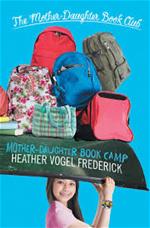 Fans of the Mother-Daughter Book Club series are in for a treat as Emma, Jess, Cassidy, Megan, and Becca head off to work as camp counselors at Camp Lovejoy in New Hampshire for their final summer before college. When new campers become homesick, it seems only natural that the girls decide to start a book club with their young charges. The alternating first-person chapters are introduced with epigraphs from Dorothy Canfield Fisher’s Understood Betsy, the book the camp book club reads. In this seventh and final book in the popular series, readers who’ve grown up with these five friends will enjoy catching up with their favorite characters’ lives and also bid a fond farewell to the Mother-Daughter Book Club girls as they head off to college.
Fans of the Mother-Daughter Book Club series are in for a treat as Emma, Jess, Cassidy, Megan, and Becca head off to work as camp counselors at Camp Lovejoy in New Hampshire for their final summer before college. When new campers become homesick, it seems only natural that the girls decide to start a book club with their young charges. The alternating first-person chapters are introduced with epigraphs from Dorothy Canfield Fisher’s Understood Betsy, the book the camp book club reads. In this seventh and final book in the popular series, readers who’ve grown up with these five friends will enjoy catching up with their favorite characters’ lives and also bid a fond farewell to the Mother-Daughter Book Club girls as they head off to college.
Summerlost. Ally Condie. 2016. Dutton/Penguin.
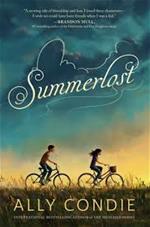 Cedar, her younger brother Miles, and her mom are working through the grieving process after her father and younger brother, Ben, were killed in a car accident. This is the first summer without her dad and Ben. They are spending the summer in Iron Creek, the place where her mother grew up. Summerlost is the name of the Shakespearean festival that runs on the local college campus all summer and is where Cedar makes a new friend, Leo, who talks her into working at the festival. Leo and Cedar design a plan to run unauthorized walking tours about the life of actress Lisette Chamberlain, Iron Creek’s most famous resident, who started her acting career with the festival and whose death has been shrouded in mystery. A wonderful summertime read with themes of loss, friendship, finding oneself, letting go, and growing up.
Cedar, her younger brother Miles, and her mom are working through the grieving process after her father and younger brother, Ben, were killed in a car accident. This is the first summer without her dad and Ben. They are spending the summer in Iron Creek, the place where her mother grew up. Summerlost is the name of the Shakespearean festival that runs on the local college campus all summer and is where Cedar makes a new friend, Leo, who talks her into working at the festival. Leo and Cedar design a plan to run unauthorized walking tours about the life of actress Lisette Chamberlain, Iron Creek’s most famous resident, who started her acting career with the festival and whose death has been shrouded in mystery. A wonderful summertime read with themes of loss, friendship, finding oneself, letting go, and growing up.
Ages 15+
Boys of Summer. Jessica Brody. 2016. Simon Pulse/Simon & Schuster.
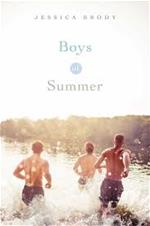 High school seniors Ian, Mike, and Grayson have spent every summer together on the island of Winlock Harborsince they were young. But this summer nothing is quite the same. Mike and his on-again, off-again girlfriend Harper have broken up; Grayson is nursing a painful arm injury, which may jeopardize his prospects for playing football at Vanderbilt, and is angry at his mom for walking out on their family; and Ian is not dealing well with the tragic death of his father, a soldier. The three friends find themselves drifting further and further apart until dealing with a series of conflicts and problems forces them to pull together or risk ruining their friendship forever.
High school seniors Ian, Mike, and Grayson have spent every summer together on the island of Winlock Harborsince they were young. But this summer nothing is quite the same. Mike and his on-again, off-again girlfriend Harper have broken up; Grayson is nursing a painful arm injury, which may jeopardize his prospects for playing football at Vanderbilt, and is angry at his mom for walking out on their family; and Ian is not dealing well with the tragic death of his father, a soldier. The three friends find themselves drifting further and further apart until dealing with a series of conflicts and problems forces them to pull together or risk ruining their friendship forever.
Summer of Supernovas. Darcy Woods. 2016. Crown/Random House.
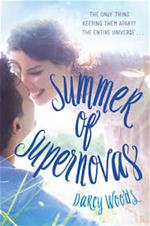 It’s summer, and 17-year-old Wilamena Carlisle is looking for love. In fact, according to her astrological chart (which she has followed to the letter ever since her mother’s death), she has exactly 22 days to find the perfect match. So she and her best friend, Irina, make it their mission to find someone who will align with her astrological sign. Before you know it, Wil finds herself in the middle of a love triangle with two brothers, Seth and Grant, one who is a match made in Zodiac heaven and one who definitely is not. Will Wil follow her heart or her chart? Finding out makes this a super summer read.
It’s summer, and 17-year-old Wilamena Carlisle is looking for love. In fact, according to her astrological chart (which she has followed to the letter ever since her mother’s death), she has exactly 22 days to find the perfect match. So she and her best friend, Irina, make it their mission to find someone who will align with her astrological sign. Before you know it, Wil finds herself in the middle of a love triangle with two brothers, Seth and Grant, one who is a match made in Zodiac heaven and one who definitely is not. Will Wil follow her heart or her chart? Finding out makes this a super summer read.
Jennifer W. Shettel is an associate professor at Millersville University of Pennsylvania, where she teaches undergraduate and graduate course in literacy for preservice and practicing teachers. Prior to joining the faculty at Millersville, she spent 16 years as an elementary classroom teacher and reading specialist in the public schools.
These reviews are submitted by members of the International Literacy Association's Children's Literature and Reading Special Interest Group (CL/R SIG) and are published weekly on Literacy Daily.